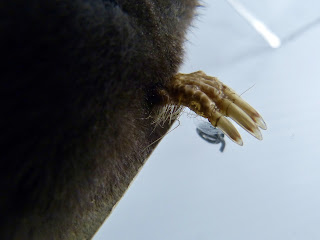Specimen of the Month: A Bizarre Star
A single star-nosed mole rests on a densely arranged shelf of small taxidermy mounts in collection storage. I regularly glance at the specimen as I enter the room to attend to a myriad of other tasks. Its body is much like that of many other neighboring small mammals--that is except for its strikingly bizarre nose and and fiercely clawed feet. The mole is visibly fascinating, but the various adaptations it has developed require a bit of an explanation to truly appreciate this species. Of the various oddities in our collection of animals, the common yet complex star-nosed mole leads a truly bizarre life.
 |
| The Museum's only star-nosed mole specimen has some minor damage, but most sensory "rays" can be observed. |
Admittedly, I have yet to come across a live one. I'm told that they are nearly blind and that is why they have evolved a sensory organ akin to tiny, pink tentacles. These appendages may not appear so on our specimen--each of the 22 rays have either dried to a dingy gray or even broken off during previous handling. These look more delicate than powerful. But during life, a star-nosed mole is ever-reliant on those hypersensitive rays to expertly probe the surrounding soil while it forages a landscape of perpetual darkness. Thousands of receptors transmit information to the mole's brain within milliseconds, effectively creating an image for a legally blind creature in an underground world.
Funnily, a star-nosed mole's sensory adaptations don't stop there. Have I mentioned that they are nearly blind? Their eyes are so small that they aren't very functional or even visible to my eyes. A taxidermist need not even include artificial eyes if they were in a rush. So, star-nosed moles have yet another feature which is easily observed on the Museum's specimen. To supplement the rays at the tip of their face, these moles have specialized hairs just behind their snout and along the edge of their forepaws. Commonly called whiskers, vibrissae are surrounded by nerve cells where they are rooted into the skin. Vibrissae help the majority of mammals to sense the world around them through touch.
Star-nosed moles are not the easiest animals to come across or even find signs of. Their tunnels don't leave mounds in yards--those are created by another species of mole. Star-nosed moles tend to spend their lives in wet habitats. They will swim for aquatic prey and can even smell underwater by releasing and quickly retrieving air bubbles for picking up scents.
Still, we do have a chance at spotting one--even at this time of year. In addition to adaptations for sensing the world around them, they have methods to survive cold weather too. These moles are active during winter so have waterproof fur and can store additional fat in their tail. Even though they might spend most of their time under tall packs of snow or in frigid water, I delight in the prospect of coming across a star-nosed mole while navigating our snow-covered landscape. Until then, I'll keep the Museum's specimen in close view.
Funnily, a star-nosed mole's sensory adaptations don't stop there. Have I mentioned that they are nearly blind? Their eyes are so small that they aren't very functional or even visible to my eyes. A taxidermist need not even include artificial eyes if they were in a rush. So, star-nosed moles have yet another feature which is easily observed on the Museum's specimen. To supplement the rays at the tip of their face, these moles have specialized hairs just behind their snout and along the edge of their forepaws. Commonly called whiskers, vibrissae are surrounded by nerve cells where they are rooted into the skin. Vibrissae help the majority of mammals to sense the world around them through touch.
 |
| Above, vibrissae provide additional sensory input behind the mole's star-like snout. Below, they can also be found along the edge of their forepaws. |
 |
| A live star-nosed mole caught during winter. Getty Images |
